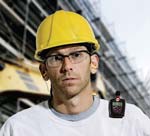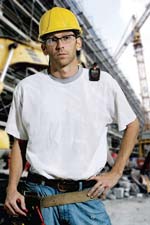
Hearing Conservation: Going from Compliance to Effectiveness
You can achieve this. Five strategic fundamentals need to be present and active for the five or six traditional tactics to achieve results.
- By Jim Banach
- Mar 01, 2010

Quest Technologies Inc., a 3M Company.
Hearing conservation continues to be an interesting challenge. The fact is, noise-induced hearing loss is totally within our means to eliminate. It is as simple as not allowing any hazardous noise to reach the ear of the worker. While that is easy to say, the activities of the workplace, the behaviors of workers, and the economic realities all make this an oversimplification. As of now, we do not have a quick fix for the elimination of hazardous exposures to the worker, and a medical intervention is not practical, either. So we must face the reality that the hearing conservation efforts are interdisciplinary, integrated, and in need of leadership that executes a detailed and appropriate plan.
The traditional basic parts of an "effective hearing conservation program" are well known. Various regulations and standards around the world gravitate toward the same components. Typically, they include noise measurement, audiometric testing, hearing protection, education and training, and documentation or recordkeeping. The earliest proponents of hearing conservation included noise control in this list and considered it to be the starting point of a hearing conservation program. All too often, the appropriate application of noise controls is overlooked as being too expensive or complicated. In reality, this is often due to the involvement of a so-called expert who really isn't one.
While all of these parts may be in place to at least some degree, it is inappropriate to assume an "effective" program is the result. Rather than lead to solutions, the five or six elements may do nothing more than provide the documentation to prove the hearing conservation program is not working.
There are an additional five strategic fundamentals that need to be present and active for the five or six traditional tactics to achieve results. These include leadership, integration, evaluation, communication, and, most importantly, the buy-in of the true owner of noise-induced hearing loss.
Leadership
Leadership is not about who gets blamed if anything goes wrong or if failure arises. And, very often, leadership is not about the person with the most or the highest educational degree(s). For the audiometric review, a professional supervisor — an audiologist or physician, typically — is necessary, but that isn't the same as leadership. Managing the budget for the hearing conservation program isn't leadership, either.
Leadership in a hearing conservation program requires drive, passion, and authority with responsibility. It can be provided by the nurse, industrial hygienist, safety engineer, or even the human resources manager. It isn't rooted so much in the technical knowledge as it is in the outcomes, desire, and accountability. It is about drawing the various technical disciplines together to achieve an outcome: the reduction and eventually the elimination of all incidence of noise-induced hearing loss.
In so many hearing conservation programs, the one in charge is a reluctant participant stuck with a responsibility. Effective leadership in hearing conservation is no different than effective leadership in business or life in general: It must be centered on principles, prioritized, measured, adjusted, and continued.
Leadership is also not a lone activity. It must be supported by executive management as a business principle, and the team members must work together. There is no room for territorial behavior. The desired outcome needs to be more important than any distracting agenda.
Integration
Integration is about bringing the disparate segments of the hearing conservation program together through the common and overlapping threads that exist. These often lie in the needed information that must flow to make each of the stand-alone pieces effective.
For example, selecting the appropriate protection requires a clear understanding of the noise levels that are present, whether they are steady state or intermittent, whether they are frequency-specific or broad band. Is there a dominant frequency? Is it within the range of frequencies the protector is most effective at limiting?
A time-weighted average of 95 decibels would indicate the need for hearing protection. Simply observing a 95 dB TWA and then determining the hearing protection for the entire work shift may or may not be an appropriate solution. It is possible that higher levels occur for part of the shift , but there also may be prolonged periods when the noise levels are well below a hazardous level. During the quiet times, the protection is unnecessary, but requiring the protection to be worn may reduce the credibility when it is really needed…sort of the "cry wolf" syndrome.
Peak levels reported during exposure sampling also can be misused. High peak levels in excess of 130 dB may or may not result from noises that actually reach the ear. False readings may arise from microphones being touched or bumped against surfaces. There is value in the information, but only as far as it is understood and correctly applied.
Noise exposure, the controls applied, the protection selected, and the determination of work-related hearing loss are all intimately interconnected. It is important to understand these relationships so that exposure measurements do more than document compliance, they actually provide the information needed for the other program segments to be effective.
Evaluation
Measurements and their evaluation help to determine how much change has been achieved. Evaluation moves a program from a compliance focus to a true understanding of what works and doesn't and the progress being made to a desired outcome.
Before and aft er noise level measurements are core to assessing the successful outcome of noise control efforts. Fit testing of hearing protection helps both the provider and the worker understand good fitting technique and the realistic expectations for the protection's performance for the individual worker. Hearing protection usage surveys in the workplace will prove out whether the protection is where it needs to be: in the ears. It is as simple as periodically taking the time to look. Are the muffs over the ears or around the neck? Is that string on the plugs keeping the plugs from falling, or is it being used as a necklace?
Audiometric data analysis is the ultimate measure of how well a program is achieving its goal. However — and this is truly important — by the time we know the outcomes from this evaluation, it is too late for the worker. So while this analysis is important, it needs to be kept in its proper perspective. Long before we get to the audiometric analysis, we'd better know that each preceding part is effective.
Communication
I can remember when the paramount concern of most employers was to keep the employee from knowing any information regarding the hearing conservation program. One of the key features asked for in noise dosimeters was the ability to keep their eyes offthe numbers. There was a philosophy of not letting them know anything because they would probably file for worker's compensation.
Not involving and informing the employee is like trying to solve a jigsaw puzzle with a missing piece. The one who understands the work activity better than anyone else is the one doing it. The one who can most affect the control of the exposure is the one who has to wear the protection, utilize the tools properly, or keep the noise controls in place.
The European Union in its hearing conservation directive mandates the use of signage to communicate the presence of a hazard. While a simple sign on its face doesn't seem that significant, it is part of creating awareness, accepting the reality of a hazard, and putting it out front that responsibility for prevention is acknowledged.
Today, dosimeters are available that signal to the worker when a hazardous level exists. Also, low-cost personal indicating devices may be provided to the worker so they can be factually aware of when noise levels have reached hazardous values or when they are low enough that it may be safe to remove hearing protection. The more the worker understands the exposure, the protection, and the desired outcomes, the more that worker can contribute.
The Owner
In all of these efforts, it is important to remember who is the ultimate owner of the outcome of an effective hearing conservation program. While employers pay for the program elements, the true outcome belongs to the workers. They are the ones who will keep their loss long aft er the job is done. The achievement of an effective program is hard to imagine without their input and contribution.
Certainly, including the employee is a cultural change, but it is one that can arise out of other programs that are already active in the workplace. If lean concepts, quality programs, and wellness efforts are already occurring, stretching to include occupational safety and health is not a big leap.
Conclusion
Hearing conservation has been in place for decades. Effective hearing conservation is a growing concept. It requires true leadership, the use of all of the tactics available, and the involvement of all stakeholders. It is truly a management — or, better said, leadership — challenge that can be achieved.
This article originally appeared in the March 2010 issue of Occupational Health & Safety.